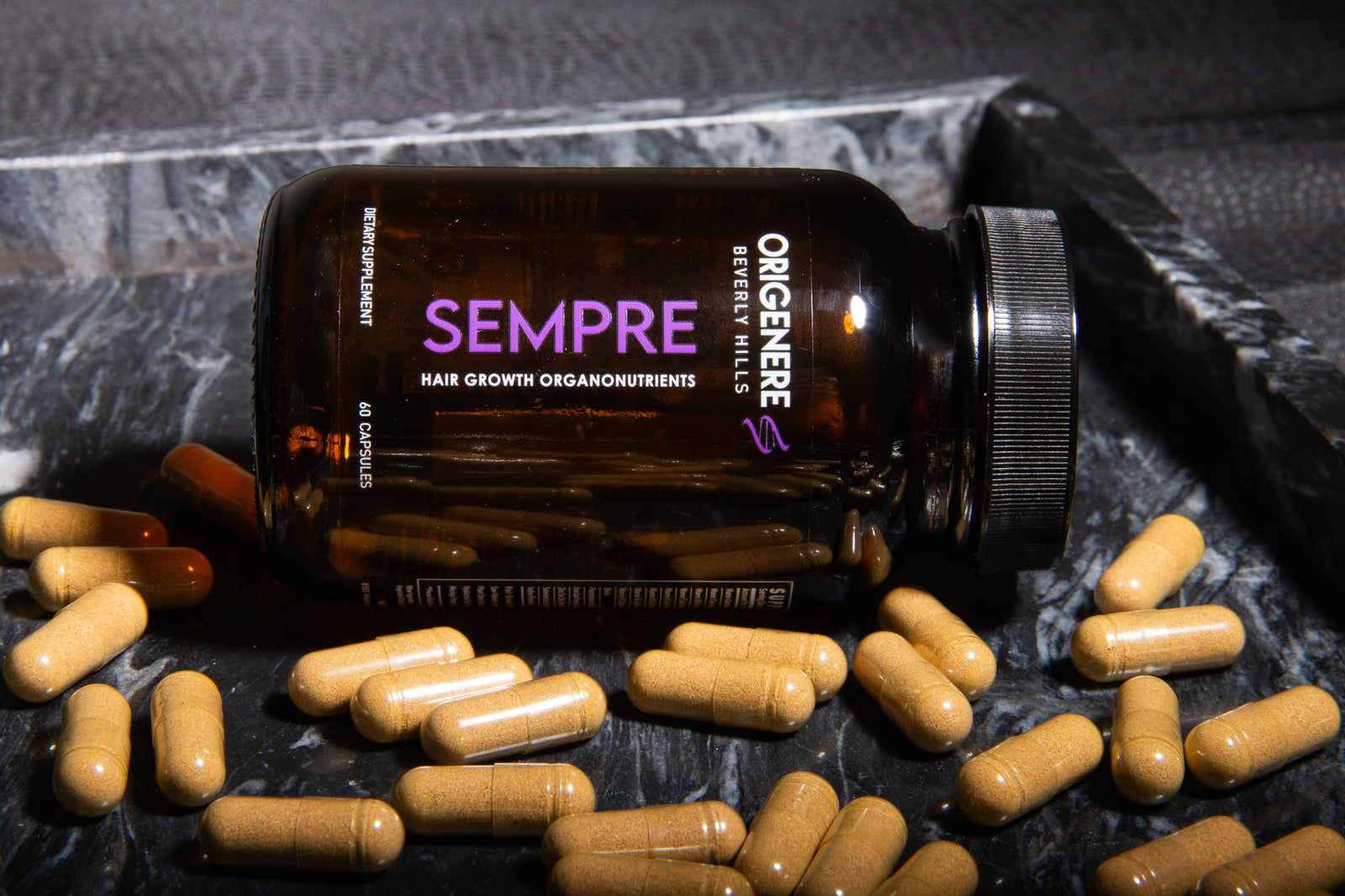Understanding the Hair Growth Cycle: A Foundation for Healthy Hair

Understanding the hair growth cycle is fundamental for those embarking on a journey for thicker, fuller hair. The basic principles of the hair growth cycle empower us to make informed decisions in nurturing our hair. As part of our series on hair growth, let’s delve into the basics of the hair growth cycle, its phases, and the factors influencing it.
The Hair Growth Cycle: An Overview
Hair growth is not a continuous, linear process but follows a cyclical pattern that includes growth, regression, rest, and shedding. This cycle ensures the renewal of our hair, maintaining a balance between the hairs that are growing and those that are ready to fall out. Understanding this cycle is crucial for anyone looking to combat thinning hair and promote hair growth, especially when using all-natural hair care solutions. Each person has about 100,000 hair scalp hairs and sheds about 100 to 150 telogen hairs daily.
Phases of Hair Growth
The hair growth cycle consists of three main phases:
Anagen (Growth Phase): This is the phase where hair actively grows. It can last anywhere from two to seven years and determines the length of our hair. During the anagen phase, hair follicles push out hairs that will continue to grow until they are cut or reach the end of their lifespan.
Catagen (Transition Phase): Following the anagen phase, hair enters the catagen phase, a short transitional period that lasts about two to three weeks. During this time, the hair follicle shrinks and detaches from the dermal papilla, a structure crucial for hair growth
Telogen (Resting Phase): The final phase is the telogen phase, during which hair does not grow but does not fall out either. This phase lasts for about three months. At the end of the telogen phase, the hair is shed, and the follicle begins a new cycle.

Factors Influencing the Hair Growth Cycle
Hair follicles need basic elements to thrive including oxygen, blood supply, stem cells, and the proper hormonal signals. Many factors can impact the hair growth cycle, affecting hair thickness, growth rate, and overall health. These include:
- Genetics: Our genes play a significant role in determining hair density, growth rate, and the likelihood of experiencing hair thinning or loss.
- Age: As we age, the rate of hair growth can slow down, and the hair follicles may stop producing new hairs, leading to thinner hair.
- Nutrition: A diet lacking in essential nutrients, vitamins, and minerals can hinder hair growth and affect hair health.
- Hormonal Changes: Hormones significantly influence hair growth, with changes often leading to increased shedding or hair thinning.
- Health Conditions: Certain medical conditions and medications can impact the hair growth cycle, resulting in temporary or permanent hair loss.
- Stress: High levels of stress can cause hair to prematurely enter the telogen phase, leading to noticeable hair shedding.
By understanding the hair growth cycle and the factors that influence it, individuals can better tailor their hair care routines to support healthy hair growth. Embracing all-natural hair care solutions, especially those targeting thinning hair, can be a gentle and effective way to nurture your hair through its natural cycle. For example, our Sempre Hair Growth Organonutrients have all natural botanicals selected for their known hair health properties including Saw Palmetto, Ashwagandha, Nettle leaf and Bamboo extract.

Ashwagandha, a prominent herb in Ayurvedic medicine, is known for its adaptogenic properties, which help the body manage stress. It's believed that ashwagandha can positively affect the hair growth cycle, mainly due to its ability to reduce stress and potentially improve overall scalp and hair health through its anti-inflammatory and antioxidant effects. Here's how ashwagandha might influence the different phases of the hair growth cycle:
Anagen Phase (Growth Phase): Stress is known to negatively affect the anagen phase, potentially shortening it and leading to premature hair loss. Ashwagandha might promote hair growth by reducing cortisol levels, a stress hormone that can shorten the anagen phase. By mitigating stress and possibly enhancing the delivery of nutrients to the hair follicles, ashwagandha could support a longer and healthier anagen phase, encouraging robust hair growth.
Catagen Phase (Transition Phase): While specific effects of ashwagandha on the catagen phase are not well-documented, its overall benefits in reducing stress and improving follicular health might help ensure that the transition from the anagen phase to the catagen phase is regulated properly. This could help prevent premature entry into the catagen phase, which is crucial for maintaining hair density and scalp coverage.
Telogen Phase (Resting Phase): Ashwagandha's potential to reduce stress and its anti-inflammatory properties might benefit the telogen phase by creating a healthier scalp environment. This could reduce the number of hair follicles prematurely entering the telogen phase due to stress or inflammation, thereby decreasing overall hair shedding.
Exogen Phase (Shedding Phase): By potentially supporting a longer anagen phase and a healthier scalp environment, ashwagandha may indirectly influence the exogen phase, leading to reduced hair shedding. Hair that remains longer in the anagen phase would, ideally, be less prone to shedding during the exogen phase.
Incorporating a holistic approach that addresses nutritional, hormonal, and stress-related factors, alongside using quality natural hair care products, can create the optimal environment for healthy hair growth. Stay tuned for more insights in our series on hair growth, where we will explore detailed strategies and tips for nurturing your hair at every stage of its growth cycle.
Sources:
Natarelli N, Gahoonia N, Sivamani RK. Integrative and Mechanistic Approach to the Hair Growth Cycle and Hair Loss. J Clin Med. 2023 Jan 23;12(3):893. doi: 10.3390/jcm12030893. PMID: 36769541; PMCID: PMC9917549.
Murphrey MB, Agarwal S, Zito PM. Anatomy, Hair. [Updated 2023 Aug 14]. In: StatPearls [Internet]. Treasure Island (FL): StatPearls Publishing; 2024 Jan-. Available from: https://www.ncbi.nlm.nih.gov/books/NBK513312/
2014. The structure of people’s hair. PeerJ 2:e619 https://doi.org/10.7717/peerj.619
Cavaleri F, Chattopadhyay S, Palsule V, Kar PK, Chatterjee R. Study of Drug Target Identification and Associated Molecular Mechanisms for the Therapeutic Activity and Hair Follicle Induction of Two Ashwagandha Extracts Having Differential Withanolide Constitutions. J Nutr Metab. 2023 Sep 30;2023:9599744. doi: 10.1155/2023/9599744. PMID: 37808919; PMCID: PMC10560109.




